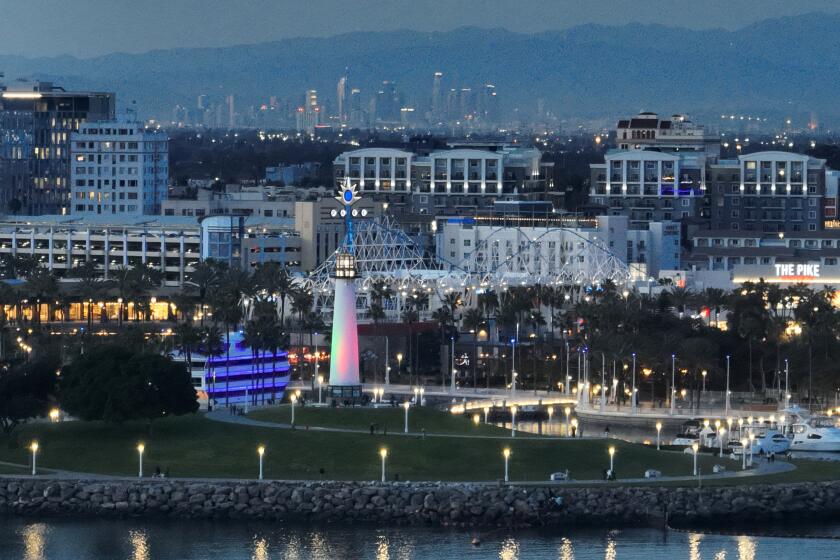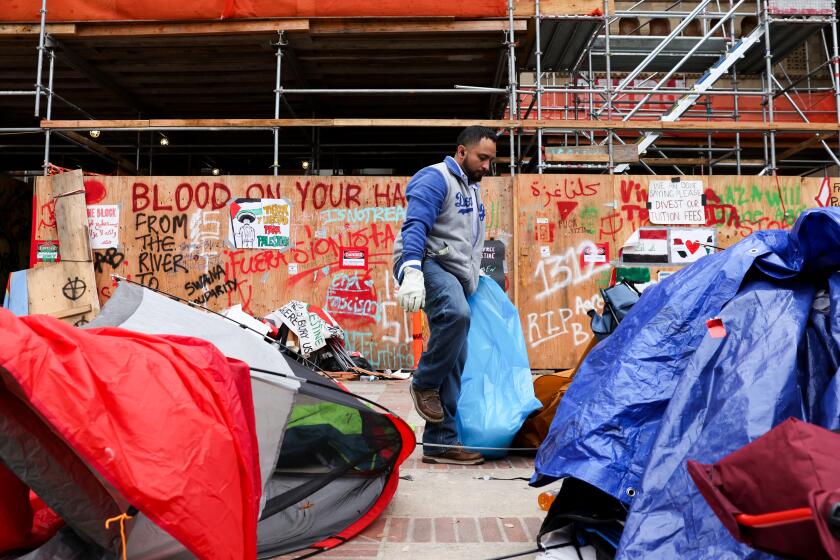California farmworker protections not going far enough?
Reporting from Buttonwillow, Calif. -- At noon, when the morning breeze had faded and the temperature hit 95, a union representative walked into the sweltering field to check on dozens of farmworkers harvesting peppers.
A middle-aged worker with a T-shirt placed under his cap to absorb sweat approached, whispering: “No hay sombra” (there is no shade).
Only after the union man appeared did two foremen pull canopies out of their trucks and call the workers in for a break.
“There’s a law for this,” the field hand said. “I’ve heard it on the news. They have to have water. They have to have shade.”
Six years after California became the first state to adopt rules requiring regular shade, water and rest for outdoor workers, adherence remains sporadic at best. Enforcement of the rules governing the state’s 35,000 farms and other outdoor operations is sketchy, and many workers don’t fully understand the protections they are entitled to.
State officials had been debating instituting heat standards for 15 years before Gov. Arnold Schwarzenegger in 2005 enacted an emergency measure after half a dozen workers collapsed and died. Since 2006, California has confirmed nine deaths of agriculture and landscape workers due to heat-related illness. This year, workplace-safety officials have said they are investigating three possible heat-related deaths of agricultural workers.
Authorities have said they are doing all they can, citing a significant increase in the number of inspections and a publicity campaign using radio, billboards and other media to tell workers about how to prevent heatstroke. Signs in English and Spanish went up in California: “Si quiere durar, No olvide descansar” (if you want to last, don’t forget to rest).
Employer groups also have boosted training efforts to comply with the rules.
But whether that is enough to force a change in the fields is uncertain.
“There’s the fear factor,” said Lupe Quintero, director of community workers in El Centro for California Rural Legal Assistance Inc. “Workers will say to me, ‘If we complain, if we ask for that extra break, if we say anything, tomorrow we are no longer employed.’ That’s what’s hard.”
According to the current standard, employers must make one quart of water per hour available to each worker and provide enough shade to cover one-quarter of the workforce when temperatures hit 85 degrees. Companies also must conduct training on heatstroke prevention and have an emergency plan in place for workers who become ill. Workers who feel they might be getting overheated are entitled to rest in a shaded area for at least five minutes.
A tour around Bakersfield area fields this summer showed a variety of shade options available. Some employers had invested in open-air, roof-covered trailers with benches where workers rest. Some had put umbrellas up on dirt roads. Others simply stretched blankets over grapevines.
“Sometimes there’s some confusion,” said William Krycia, the California Division of Occupational Safety and Health’s statewide coordinator for heat-illness prevention enforcement. “In an orchard, do you necessarily have to provide shade structures? It really depends.... In an orchard with the significant canopy, you may not need to have shade structures.... The same is true of table grapes. They’re basically long tunnels.”
Candelario Velasquez, who spent several weeks picking table grapes near Bakersfield this summer, offered his description of what it’s like to work picking inside those tunnels.
“It feels,” he said, “like you’re suffocating.”
Bryan Little, director for labor affairs of the California Farm Bureau Federation, said many employers have come to recognize that “preventing heat illnesses and dealing with them as they occur in the long run is a benefit to them.”
But worker advocates worry that the regulations allow employers too much wiggle room.
Four weeks before he arrived at the pepper farm, Armando Elenes of the United Farm Workers had driven by Uesugi Farms and felt that the contracting company, Global AG, was operating without sufficient shade. He filed a complaint with the state.
The state requires an inspection within three days, but an official didn’t show up until eight days later — a long time in the mobile world of agriculture — when no one was working in the field, according to state records.
In fact, inspectors frequently have trouble locating employees and contracting companies. Of 144 attempted inspections in 2009, more than one-third were not conducted within the required three-day window, according to records. Over the last two years, according to Cal/OSHA, 89 of 185 heat complaints filed with the state did not result in inspections.
In some cases, inspectors documented attempts to follow up, such as asking neighbors for directions to a particular work site. In others, inspection reports were closed after one attempted visit.
“They think it’s like any other job,” Elenes said. “They say, ‘Give us an address,’ but it’s not like that.” He and others have tried hand-drawing maps, printing out Google maps and directing inspectors to work sites by phone. Farmworkers filing complaints, he worried, might not be as savvy.
Cal/OSHA declined to comment on the inspection lapses, citing a pending lawsuit filed by Public Counsel, a public interest law firm, on behalf of farmworkers and the United Farm Workers.
However, agency records show that since the heat standard was implemented in 2005, the number of agricultural work site inspections for compliance has increased dramatically — from 21 that year to 927 last year.
And Cal/OSHA officials said the state had made considerable progress in improving conditions for farmworkers and others toiling in the heat. Officials in 2008, for example, began temporarily shuttering operations where heat-related violations created imminent hazards. So far, 29 outdoor work sites have been affected.
Still, Cal/OSHA’s approximately 200 inspectors can cover only a fraction of the state’s farms. So organizations like the United Farm Workers and California Rural Legal Assistance Inc. regularly conduct informal monitoring.
“Day in and day out, we hear from our clients and community members about workplace safety violations,” said Mike Meuter, an attorney with the legal aid group.
Many farmworker advocates said protections do not go far enough. The onus to recognize the symptoms of heat illness and ask for relief, they asserted, is still on the workers in California’s fields.
“Without a clear employer mandate … mere guidance to workers to drink water, seek shade and take breaks has proved wholly inadequate,” Chief Assistant Atty. Gen. Matt Rodriguez wrote in 2009, requesting that the state standards board allow Cal/OSHA to raise heat-protection requirements.
At Uesugi Farms in Buttonwillow, the worker who complained to Elenes about the lack of shade told of one woman who had become sick the day before and crawled under a truck to escape the sun.
“Yesterday they didn’t put up anything at all” to provide shade, he said.
The farmworker didn’t want to give his name, fearing retribution. Still, he wanted others to know what was happening at his work site.
After several minutes of rest under the newly erected canopies, the foremen called their workers back into the fields.
More to Read
Start your day right
Sign up for Essential California for news, features and recommendations from the L.A. Times and beyond in your inbox six days a week.
You may occasionally receive promotional content from the Los Angeles Times.







